
The New Haven Green is a 16-acre (65,000 m2) privately owned park and recreation area located in the downtown district of the city of New Haven, Connecticut, United States. It comprises the central square of the nine-square settlement plan of the original Puritan colonists in New Haven, and was designed and surveyed by colonist John Brockett. Today the Green is bordered by the modern paved roads of College, Chapel, Church, and Elm streets. Temple Street bisects the Green into upper (northwest) and lower (southeast) halves.

The Cathedral of St. Joseph in Hartford, Connecticut, United States, is the mother church and seat of the Archdiocese of Hartford. Dedicated on May 15, 1962, it stands on the site of the old cathedral which had been destroyed in a fire. It is located on Farmington Avenue just outside downtown Hartford.
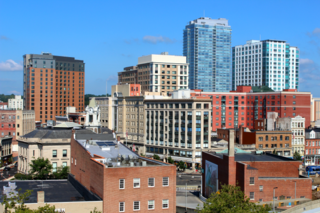
Downtown Stamford, or Stamford Downtown, is the central business district of the city of Stamford, Connecticut, United States. It includes major retail establishments, a shopping mall, a university campus, the headquarters of major corporations and Fortune 500 companies, as well as other retail businesses, hotels, restaurants, offices, entertainment venues and high-rise apartment buildings.
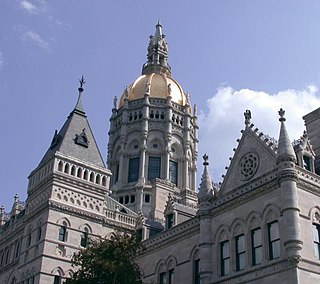
The neighborhoods of Hartford, Connecticut in the United States are varied and historic.

The Downtown North Historic District is a 19-acre (7.7 ha) historic district in Hartford, Connecticut. It is a predominantly residential area located around Main Street and High Street north of I-84 and south of the Amtrak railroad tracks. Its apartment blocks, houses, schools and churches, built up mainly in the late 19th and early 20th centuries as part of an expansion of the city's urban core. It includes the 130-foot (40 m) Keney Tower. The area was listed on the National Register of Historic Places in 2004.

The South Congregational Church is a historic church at 90 Main Street in New Britain, Connecticut. It is a large brownstone Gothic Revival structure, located at a central intersection in the city's heart. The church was built in 1865, with the parish house added in 1889. Both were designed by the noted Boston architect George F. Meacham. The congregation was established in 1842, and was merged with First Baptist Church in 1974. The building was listed on the National Register of Historic Places in 1990.

The Hunt Memorial Library, also known as the John M. Hunt Memorial Building, is a historic former library building at 6 Main Street in downtown Nashua, New Hampshire. Built in 1903, it is a significant early work of the renowned Gothic Revival architect Ralph Adams Cram, then in partnership with Goodhue and Ferguson. The Nashua Public Library moved to a new building in 1971. The building is owned by the city and is available for rent for functions. It was listed on the National Register of Historic Places in 1971.

The First Methodist Church of Burlington is a historic church located at 21 Buell Street in Burlington, Vermont. Built in 1869 to a design by Alexander R. Esty, it is the city's only example of ecclesiastical Romanesque Revival architecture. It was listed on the National Register of Historic Places in 1978.

Holy Trinity Episcopal Church also known as Holy Trinity Memorial Church is an historic Episcopal church building located at 38 Grand Avenue in the village of Swanton, Franklin County, Vermont. Built in 1876 and expanded in 1909-10, the church facilities include a fine example of the Carpenter Gothic in the older section, and the Late Victorian Gothic Revival in the newer section. The church was listed on the National Register of Historic Places as the Parish of the Holy Trinity in 2001. The church is an active parish in the Episcopal Diocese of Vermont; its current rector is the Rev. Reid D. Farrell.

The Church of the Good Shepherd and Parish House is an Episcopal church at 155 Wyllys Street in Hartford, Connecticut. It was commissioned by Elizabeth Jarvis Colt, the widow of Samuel Colt, and completed in 1867. The church and its associated parish house were designed by Edward Tuckerman Potter, and serve as a memorial to Samuel Colt and members of his family. The church and parish house were added to the National Register of Historic Places in 1975, and became a contributing property to the Coltsville Historic District in 2008.
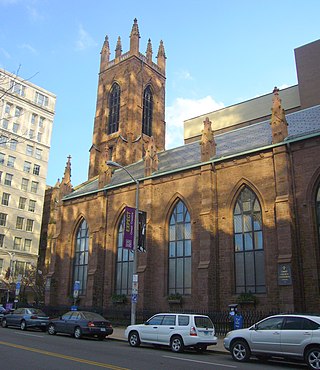
Christ Church Cathedral is a historic church at 955 Main Street in downtown Hartford, Connecticut. Built in the 1820s to a design by Ithiel Town, it is one of the earliest known examples of Gothic Revival architecture in the United States. It was listed on the National Register of Historic Places in 1983. It is the cathedral church of the Episcopal Diocese of Connecticut, whose offices are next door at 45 Church Street.
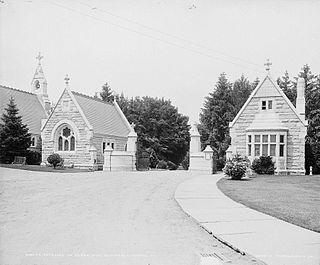
Northam Memorial Chapel and Gallup Memorial Gateway, also known as Cedar Hill Chapel and Gateway, are a historic chapel and gateway in the Cedar Hill Cemetery at 453 Fairfield Avenue in Hartford, Connecticut, USA. Although not part of that cemetery's original rural cemetery design, they are a prominent work of architect George Keller, designed in 1882 and completed in 1889. The Gothic Revival structures were listed on the National Register of Historic Places in 1982.

The South Green Fire Station, also known as the Engine Company 1 Fire Station, is at 197 Main St. in downtown Hartford, Connecticut. Built in 1927, it is an architecturally distinctive example of Classical and Collegiate Gothic Revival architecture, designed by a prominent local firm. The station, as well as the former fire equipment maintenance house behind it at 36 John Street, were listed on the National Register of Historic Places in 1989. The station presently houses Engine Company 1 and Ladder Company 6 of the Hartford Fire Department.

The Hartford Municipal Building, also known as Hartford City Hall, is a historic Beaux-Arts structure located at 550 Main Street in Hartford, Connecticut. Completed in 1915, it is a prominent local example of Beaux-Arts architecture, and is the third building to serve as city hall. It was added to the National Register of Historic Places in 1981.
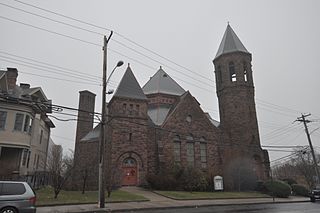
The First Baptist Church is a historic church at 126 Washington Avenue in Bridgeport, Connecticut. Built in 1893, it is a distinctive local example of Richardsonian Romanesque architecture, designed by local architect Joseph W. Northrop for a congregation founded in 1837. It was listed on the National Register of Historic Places in 1990.

The Asylum Avenue District encompasses the institutional core of the Asylum Hill neighborhood of Hartford, Connecticut. Located just west of Downtown Hartford across Interstate 84, it includes four churches, a school, and a handful of adjacent 19th-century residences. It was listed on the National Register of Historic Places in 1979.

777 Main Street is a residential skyscraper in Downtown Hartford, Connecticut. Built in 1967, it is a prominent local example of Mid-Century Modern architecture, designed by Welton Becket. It was listed on the National Register of Historic Places in 2014, and was converted to residential use. The building is LEED Platinum® certified by the U.S. Green Building Council, and is Connecticut's first microgrid. Clean, combustion-free renewable energy to power and heat the building is created on-site from 336 Rooftop Solar panels and a 400 kilowatt fuel cell. These clean energy sources also power the 31 electric charging stations in the building's garage, helping to bolster clean commuting.

The First Lutheran Church of the Reformation is a historic church at 77 Franklin Square in New Britain, Connecticut. The congregation was founded in 1885 and the current church building was constructed 1903-07. The building, a fine local example of Late Gothic Revival architecture, was added to the National Register of Historic Places in 2010.

The Ansonia Library is the public library serving Ansonia, Connecticut. It is located at 53 South Cliff, in an architecturally distinguished Richardsonian Romanesque building designed by Connecticut architect George Keller and completed in 1892 as a gift from Caroline Phelps Stokes. It was listed on the National Register of Historic Places on August 23, 1985.

The Webster Memorial Building is a historic house at 36 Trumbull Street in downtown Hartford, Connecticut. Built in 1870 and extensively restyled in 1924, it is a rare example of Georgian Revival architecture in the downtown area, noted for its historical association with the Family Services Society, a prominent local charity. The building, now in other commercial use, was listed on the National Register of Historic Places in 1982.






















